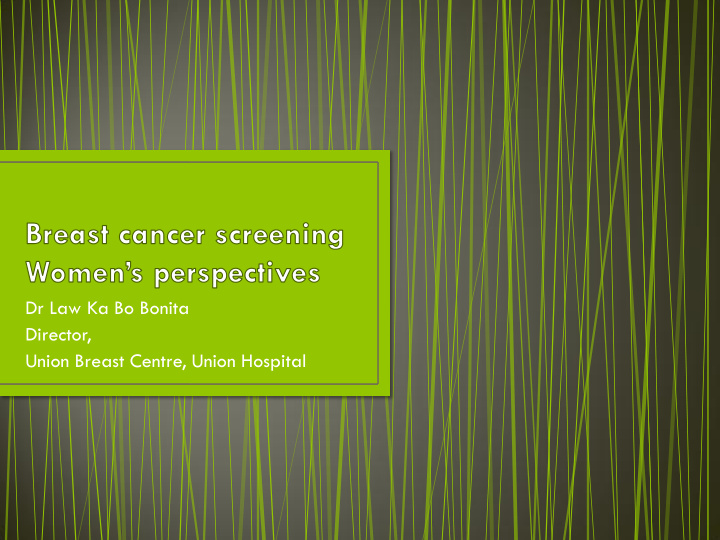



Dr Law Ka Bo Bonita Director, Union Breast Centre, Union Hospital
• Why to screen • Benefits • Harms : overdiagnosis, over treatment, false + results • Balance • Worth to screen: own risk assessment: risk stratification • Informed consent: with reference to guidelines + trial results • How to screen • When to start • Where to screen • What modalities • Setting; expertise, onsite reading, result explanation • Organsied screening vs opportunistic screening • Cost
Woloshin. JAMA 2010;303(2):164-165
• Screening for breast cancer has been evaluated by 9 randomized trials over 5 decades and recommended by major guideline groups for more than 3 decades. • Overall reduction in breast cancer mortality by 25-30% in randomized controlled trials for age 50-69 (WHO 2002)
• estimated that without screening, 3.5 of 1000 women in their 40s will die of breast cancer over the next 10 years • Screening reduces the chance of breast cancer death from 3.5 to about 3 of 1000.
• The most recent meta-analysis found that breast cancer mortality reduction among women invited to screening :- • 15% for women aged 39 – 49 years, • 14% for women aged 50 – 59 years, • 32% for women aged 60 – 69 years
• Life-year saved is more for younger age, not just measuring reduction in breast cancer mortality • 34% total life loss from CA breast • Incidence in HK before age 50 equal to after 50 • Higher False +, less sensitivity (supplementary USG; digital MMG) • Shorter interval yearly screen • screening should be made available
• Radioation risk : minimal , safety confirmed • 50-200/1000 screens • possible harmful effects of false-positive results • Recalls, interventions, anxiety • 91% – 98.6% of abnormal mammograms are false+ • Follow-up testing after false + tests adds about 33% to the cost • higher levels of distress and anxiety • think more about breast cancer, • increase subsequent use of screening mammography • women viewed false positives as acceptable consequences
• 40% of women who had a false-positive mammogram result described the experience as “very scary” • all said they were glad they had undergone the test • >1/3 reported they would tolerate >10 000 false-positive mammograms for every breast cancer death avoided
• anxiety was highest for women who needed biopsy • second-highest among women asked 6 month follow up • Only those women for whom onsite reading and immediate follow-up were available had lower anxiety scores
• “earlier a cancer is found, the better the chance of cure” • cancers found on screening that will not cause death or symptoms if left alone • unnecessarily diagnosed, undergo treatment that can only cause harm, and must live with the ongoing fear of cancer recurrence • Incidence of DCIS increased after screening • not possible to know which women are overdiagnosed as all are treated up to 24%
• in the clinical trials, breast cancer diagnosis in the screened group remained persistently higher even after many years. This persistent difference represents overdiagnosis • Based on 15-year follow-up of the Malmo trial, 2 women are overdiagnosed for every breast cancer death avoided. Gøtzsche et al estimated this ratio to be 10 to 1.
• Only 7% of women believes in possibility if breast cancers that grow so slowly that even without treatment a woman’s health would not beaffected
• With the help of her physician, needs to consider these harms and benefits and decide whether to undergo screening • The benefits and harms of screening vary with age • • The USPSTF concluded that benefit outweighs harm for aged 50 to 74 years, probably for women younger than 50
• Evaluation of effectiveness of screening – clinical, epidemiological, economic data • Possibly with risk stratifications • Women’s perpsectives and preferences • Survey of 500 people (Schwartz 2004) • 87% routine cancer screening is a good idea • 56% wanted to be tested even for slow growing cancer Hersch et al. Prev Med 2011,doi:10.1016/j ypmed 2011.06.013
• Personal risk assessment • Family history, menstrual history, reproductive history • Recommendation for screening • Higher risk individuals more likely to have benefits overweighing harms
Recommend
More recommend